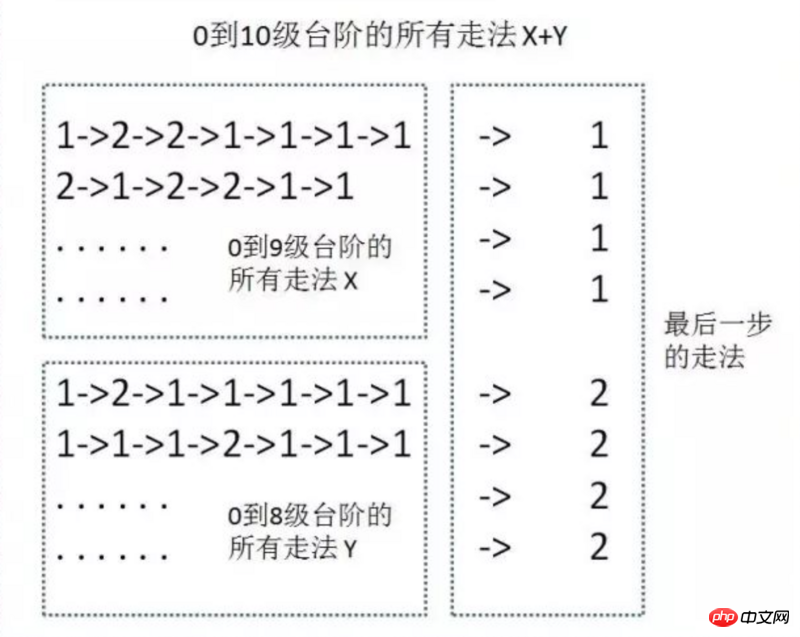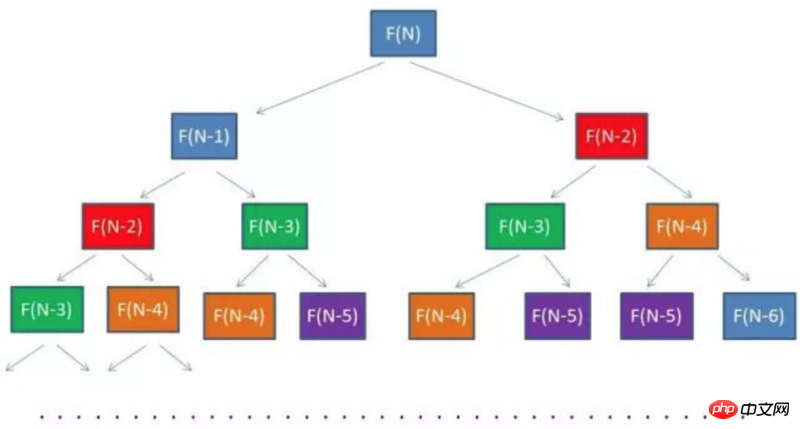 Web Front-end
Web Front-end
 JS Tutorial
JS Tutorial
 Detailed case explanation: Introduction to dynamic programming (taking stairs as an example)
Detailed case explanation: Introduction to dynamic programming (taking stairs as an example)
Detailed case explanation: Introduction to dynamic programming (taking stairs as an example)
Concept
Dynamic programming (dynamic programming) is a branch of operations research and a mathematical method for optimizing the decision process.
Dynamic programming algorithms are usually based on a recursion formula and one or more initial states. The solution to the current subproblem will be derived from the solution to the previous subproblem .
Basic idea
To solve a given problem, we need to solve its different parts (i.e.solve subproblems), and then combine the solutions of the subproblems to get Solution to the original problem.
Usually many sub-problems are very similar, so the dynamic programming method tries to only solve each sub-problem once , thereby reducing the amount of calculation.
Once the solution to a given sub-problem has been calculated, it is memorized and stored so that the next time the solution to the same sub-problem is needed, the table can be directly looked up.
This approach is particularly useful when the number of repeated subproblems grows exponentially with the size of the input.
Dynamic programming has three core elements:
1. Optimal substructure
2. Boundary
3. State transition equation
Let’s take a look at the question
题
There is a staircase with a height of 10 steps. Walking from bottom to top, each step can only go up 1 or 2 steps. Find how many moves there are in total.
For example, taking one step at a time, taking a total of 10 steps, is one of the walking methods.
For another example, take 2 steps each time, taking a total of 5 steps. This is another way of walking.
But it’s too troublesome to calculate each step like this. We can just think about how to take the last step, as shown below
How to get to the tenth staircase= Go to the eighth stair and go to the ninth stair
We use f(n) to represent the way to go to the nth stair, so we have f(10) = f(9) f(8)
Then f(9) = f(8) f(7), f(8) = f(7) f(6)......
In this way we will get aRecursive formula:
f(n) = f(n-1) f(n-2);
There are also two Initial states :
f(1) = 1;
f(2) = 2;
This gives us the first solution
Method 1: Recursive solution
function getWays(n) { if (n < 1) return 0; if (n == 1) return 1; if (n == 2) return 2; return getWays(n-1) + getWays(n-2); }Copy after login
The time complexity of this method isO(2^n)
You can see that this is a binary tree. The number of nodes is the number of times our recursive equation needs to be calculated.
The height of the number is N, and the number of nodes is approximately 2^n
so the time is complicated The degree is approximately O(2^n)
, but can this method be optimized?
We will find that some values are repeatedly calculated, as shown in the figure below The same color represents the repeated parts, so can we record these repeatedly calculated values?
The same color represents the repeated parts, so can we record these repeatedly calculated values?
There is a second method for such optimization
Method 2: Memo Algorithm
const map = new Map(); function getWays(n) { if (n < 1) return 0; if (n == 1) return 1; if (n == 2) return 2; if (map.has(n)) { return map.get(n); } const value = getWays(n-1) + getWays(n-2); map.set(n, value); return value; }Copy after login
Because n-2 key-value pairs will eventually be stored in the map , so the space complexity is O(n), and the time complexity is also O(n)
. Keep thinking about it. This is the optimal solution. ?
Let’s go back to the original idea. We assume that the previous stairs have been walked and only consider the last step, so we come to f(n) = f(n-1) f(n-2) The recursive formula of See if it works
This is the number of moves for one and two stairs at the beginning, which is the  initial state
initial state
 Continue to the next step
Continue to the next step
Here another iteration is performed to obtain the steps of 4 stairs. f(4) only depends on f(2) and f(3) We find that each iteration only requires the results of the first two iterations. Data, there is no need to save the data of all sub-states like a memo
We find that each iteration only requires the results of the first two iterations. Data, there is no need to save the data of all sub-states like a memo
Method 3: Dynamic programming solution
function getWays(n) {
if (n < 1) return 0;
if (n == 1) return 1;
if (n == 2) return 2;
// a保存倒数第二个子状态数据,b保存倒数第一个子状态数据, temp 保存当前状态的数据
let a = 1, b = 2;
let temp = a + b;
for (let i = 3; i <= n; i++) {
temp = a + b;
a = b;
b = temp;
}
return temp;
}Copy after loginThis is where we can look at the current time complexity And space complexity
The current time complexity is still
function getWays(n) {
if (n < 1) return 0;
if (n == 1) return 1;
if (n == 2) return 2;
// a保存倒数第二个子状态数据,b保存倒数第一个子状态数据, temp 保存当前状态的数据
let a = 1, b = 2;
let temp = a + b;
for (let i = 3; i <= n; i++) {
temp = a + b;
a = b;
b = temp;
}
return temp;
}O(n)
, but the space complexity is reduced toO(1)This is the ideal result
Summary
This is just one of the simplest questions in dynamic programming, because it has only one change dimension
When the change dimensions become two, three or even more, it will be more complicated , the knapsack problem is a typical multi-dimensional problem. If you are interested, you can go online and read "Nine Lectures on Backpacks"Related recommendations:
Detailed explanation of the use of JS dynamic programming
JavaScript advanced algorithm dynamic programming example analysis
The above is the detailed content of Detailed case explanation: Introduction to dynamic programming (taking stairs as an example). For more information, please follow other related articles on the PHP Chinese website!

Hot AI Tools

Undresser.AI Undress
AI-powered app for creating realistic nude photos

AI Clothes Remover
Online AI tool for removing clothes from photos.

Undress AI Tool
Undress images for free

Clothoff.io
AI clothes remover

AI Hentai Generator
Generate AI Hentai for free.

Hot Article

Hot Tools

Notepad++7.3.1
Easy-to-use and free code editor

SublimeText3 Chinese version
Chinese version, very easy to use

Zend Studio 13.0.1
Powerful PHP integrated development environment

Dreamweaver CS6
Visual web development tools

SublimeText3 Mac version
God-level code editing software (SublimeText3)

Hot Topics
 1385
1385
 52
52
 How to implement an online speech recognition system using WebSocket and JavaScript
Dec 17, 2023 pm 02:54 PM
How to implement an online speech recognition system using WebSocket and JavaScript
Dec 17, 2023 pm 02:54 PM
How to use WebSocket and JavaScript to implement an online speech recognition system Introduction: With the continuous development of technology, speech recognition technology has become an important part of the field of artificial intelligence. The online speech recognition system based on WebSocket and JavaScript has the characteristics of low latency, real-time and cross-platform, and has become a widely used solution. This article will introduce how to use WebSocket and JavaScript to implement an online speech recognition system.
 WebSocket and JavaScript: key technologies for implementing real-time monitoring systems
Dec 17, 2023 pm 05:30 PM
WebSocket and JavaScript: key technologies for implementing real-time monitoring systems
Dec 17, 2023 pm 05:30 PM
WebSocket and JavaScript: Key technologies for realizing real-time monitoring systems Introduction: With the rapid development of Internet technology, real-time monitoring systems have been widely used in various fields. One of the key technologies to achieve real-time monitoring is the combination of WebSocket and JavaScript. This article will introduce the application of WebSocket and JavaScript in real-time monitoring systems, give code examples, and explain their implementation principles in detail. 1. WebSocket technology
 How to use JavaScript and WebSocket to implement a real-time online ordering system
Dec 17, 2023 pm 12:09 PM
How to use JavaScript and WebSocket to implement a real-time online ordering system
Dec 17, 2023 pm 12:09 PM
Introduction to how to use JavaScript and WebSocket to implement a real-time online ordering system: With the popularity of the Internet and the advancement of technology, more and more restaurants have begun to provide online ordering services. In order to implement a real-time online ordering system, we can use JavaScript and WebSocket technology. WebSocket is a full-duplex communication protocol based on the TCP protocol, which can realize real-time two-way communication between the client and the server. In the real-time online ordering system, when the user selects dishes and places an order
 How to implement an online reservation system using WebSocket and JavaScript
Dec 17, 2023 am 09:39 AM
How to implement an online reservation system using WebSocket and JavaScript
Dec 17, 2023 am 09:39 AM
How to use WebSocket and JavaScript to implement an online reservation system. In today's digital era, more and more businesses and services need to provide online reservation functions. It is crucial to implement an efficient and real-time online reservation system. This article will introduce how to use WebSocket and JavaScript to implement an online reservation system, and provide specific code examples. 1. What is WebSocket? WebSocket is a full-duplex method on a single TCP connection.
 JavaScript and WebSocket: Building an efficient real-time weather forecasting system
Dec 17, 2023 pm 05:13 PM
JavaScript and WebSocket: Building an efficient real-time weather forecasting system
Dec 17, 2023 pm 05:13 PM
JavaScript and WebSocket: Building an efficient real-time weather forecast system Introduction: Today, the accuracy of weather forecasts is of great significance to daily life and decision-making. As technology develops, we can provide more accurate and reliable weather forecasts by obtaining weather data in real time. In this article, we will learn how to use JavaScript and WebSocket technology to build an efficient real-time weather forecast system. This article will demonstrate the implementation process through specific code examples. We
 How to use insertBefore in javascript
Nov 24, 2023 am 11:56 AM
How to use insertBefore in javascript
Nov 24, 2023 am 11:56 AM
Usage: In JavaScript, the insertBefore() method is used to insert a new node in the DOM tree. This method requires two parameters: the new node to be inserted and the reference node (that is, the node where the new node will be inserted).
 Simple JavaScript Tutorial: How to Get HTTP Status Code
Jan 05, 2024 pm 06:08 PM
Simple JavaScript Tutorial: How to Get HTTP Status Code
Jan 05, 2024 pm 06:08 PM
JavaScript tutorial: How to get HTTP status code, specific code examples are required. Preface: In web development, data interaction with the server is often involved. When communicating with the server, we often need to obtain the returned HTTP status code to determine whether the operation is successful, and perform corresponding processing based on different status codes. This article will teach you how to use JavaScript to obtain HTTP status codes and provide some practical code examples. Using XMLHttpRequest
 JavaScript and WebSocket: Building an efficient real-time image processing system
Dec 17, 2023 am 08:41 AM
JavaScript and WebSocket: Building an efficient real-time image processing system
Dec 17, 2023 am 08:41 AM
JavaScript is a programming language widely used in web development, while WebSocket is a network protocol used for real-time communication. Combining the powerful functions of the two, we can create an efficient real-time image processing system. This article will introduce how to implement this system using JavaScript and WebSocket, and provide specific code examples. First, we need to clarify the requirements and goals of the real-time image processing system. Suppose we have a camera device that can collect real-time image data



